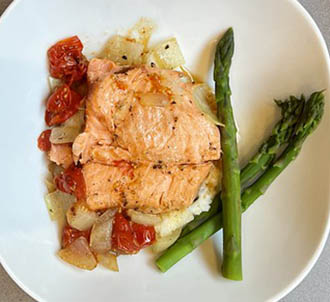Table of Contents
Buying
Arctic char is a cold-water fish that is similar in appearance to salmon and trout. It is a popular fish for cooking and eating, with a mild, delicate flavor and a firm, flaky texture.
You can buy fresh or frozen, whole, trimmed, fileted, and sometimes steaks. It is also available smoked, salt-cured, or canned.
Here are some tips on how to buy arctic char:
Look for fresh fish: When buying arctic char, always look for fresh fish. The fish should have clear, bright eyes, shiny skin, and a fresh, clean smell. Avoid fish that have dull or cloudy eyes, dull skin, or a fishy odor.
Check the color: Arctic char can be either pink or white, depending on its diet and environment. Pink flesh indicates that the fish has been eating crustaceans, while white flesh indicates a diet of fish. Choose the color that you prefer.
Consider the source: Arctic char is available wild-caught or farmed. Wild-caught fish tend to be more expensive and have a slightly stronger flavor, while farmed fish are more widely available and tend to be milder in flavor. Consider your preferences and budget when choosing between wild-caught and farmed arctic char.
If you are unsure about how to choose arctic char, don’t hesitate to ask your fishmonger for advice. They can help you choose the freshest fish and provide tips on how to cook it.
Storage
Arctic char is a delicious cold-water, oily fish that is rich in omega-3 fatty acids and protein. The best way to store arctic char is in the refrigerator for short duration up to 2 days. Keep it in an airtight container or wrapped tightly in plastic wrap. Place it on a plate or tray to catch any juices that may leak out.
Arctic char can be kept in the freezer for up to 6 months. Wrap the fish tightly in plastic wrap or foil and place it in an airtight container or freezer bag.
Cooking
Arctic char has a delicate and mild flavor with a firm texture, similar to salmon or trout. It can be cooked in a variety of ways, such as grilling, baking, broiling, or poaching. Arctic char can also be used in recipes that call for salmon or trout.
Thawing: When you are ready to use the arctic char, thaw it slowly in the refrigerator. This can take anywhere from 12 to 24 hours depending on the size of the fish. Alternatively, you can place the fish in a bowl of cold water to thaw it more quickly. Change the water every 30 minutes until the fish is thawed.
Once the arctic char is thawed, it is ready to be cooked. When cooking Arctic char, it’s important to not overcook it as this can cause the flesh to become dry and lose its delicate texture.
It is a delicious fish with a mild, delicate flavor and firm texture. It is a versatile fish that can be seasoned with a variety of herbs and spices to suit your taste.
Here are some serving ideas:
-
Grilled Arctic Char with lemon and dill: Brush both sides of the arctic char fillets with olive oil and season with salt and pepper. Grill in a preheated oven for 4-5 minutes per side, or until cooked through. Remove from grill and sprinkle with chopped fresh dill and a squeeze of lemon juice.
- Pan-Seared Arctic Char with garlic and butter.
- Enjoy baked char with maple glaze.
 |
| arctic char recipe |
Safety profile
Arctic char, being seafood, may harbor microorganisms, such as parasites, bacteria, and viruses, that may cause foodborne illness.
It is important to handle seafood safely to prevent foodborne illness. (Medical disclaimer).
Also read ≻≻-
≻≻- Channel Catfish nutrition facts.
≻≻- Trout nutrition facts.
≻≻- Salmon nutrition facts and health benefits.
≻≻-Back to Seafood from Arctic char nutrition facts and health benefits.
≻≻-Back to Home page.
Further reading (Links opens in new window):
-
U.S Fish And Wildlife Service- Alaska department of fish and game.
-
U.S Fish And Wildlife Service- Seafood source.
-
Omega-3 Fatty Acids: An Essential Contribution.





More Stories
Avocado Cacao Mousse – JSHealth
Janelle Brown on Garrison’s Mental Health Before His Death
How To Finally Beat Insomnia